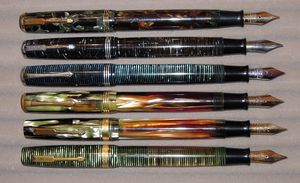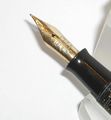Differenze tra le versioni di "Tabo Trasparente/en"
(Creata pagina con "In the '40 was maintained only the arrow clip version, with three thin cap rings and jewel and metal decoration. On all models was engraved on the pen body the ''Tabo'' br...") |
(Creata pagina con "The later versions of this model were built using a single ring on the cap, always with the arrow clip and the jewel and metal rings decorations at barrel bottom and cap t...") |
||
| Riga 34: | Riga 34: | ||
In the '40 was maintained only the arrow clip version, with three thin cap rings and [[jewel]] and metal decoration. On all models was engraved on the pen body the ''Tabo'' brand in lower case letters of larger dimensions, above the words ''TRASPARENTE'' in thinner uppercase letters. Beside the mark, at left and right respectively, were reported the data about the patent on the filling system, with the inscriptions ''brevetto'' ad ''n. 375925'' in uppercase small letters. | In the '40 was maintained only the arrow clip version, with three thin cap rings and [[jewel]] and metal decoration. On all models was engraved on the pen body the ''Tabo'' brand in lower case letters of larger dimensions, above the words ''TRASPARENTE'' in thinner uppercase letters. Beside the mark, at left and right respectively, were reported the data about the patent on the filling system, with the inscriptions ''brevetto'' ad ''n. 375925'' in uppercase small letters. | ||
| − | + | The later versions of this model were built using a single ring on the cap, always with the arrow clip and the [[jewel]] and metal rings decorations at barrel bottom and cap top. This version has been found with copies of the clip also shaped in the early versions of the pen, whose origins are unknown. | |
===Colori=== | ===Colori=== | ||
Versione delle 15:20, 18 ago 2013
History
The Tabo Trasparente model, whose production began around the late 30s (we assume around 1939, but the oldest advertisement found is 1941) was probably the most successful model produced by Tabo, so that was widely advertised in many national magazines. It remained in production until the war period, albeit subject to some changes, particularly in the form of clip and on the cap decorations.
The model dismission date is unknown, we will assume 1945, but the intake is totally arbitrary, without any factual support and performed solely for the purpose of managing the chronology.
Technical features
The main technical feature of this pen is its depression filling system, a clear imitation of the Vacumatic one. The pens were also made with transparent body in order to display the ink level. The cap was screw closed.
Materials
Pens in this series were celluloid made, with gold filled metal trim and clasp, and a 14-carat gold nib, or finished in white metal and whit a steel iridium nib (for a possible autarkic version).
Filling system
These models were equipped by an original depression filling system based on the same concepts as the Vacumatic one. In this case, however, was not necessary to remove the bottom of the pen button to access the pumping button, but this was done through the end plate itself, which is coupled to a spindle screwed to the bottom of the pen. Unscrewing the bottom extended the spindle itself and then the bottom could be used to perform the pumping operation.
Versions

The pens in this series were produced in three different sizes. There are also variants that have different clip version, the first was the classic arrow clip of Tabo Mentis, the only maintained in the subsequent period. To this one was added a brooch shaped plate clip, used in older versions, and a curved triangular terminated clip, with an arrow relief outline.
The models with shaped arrow clip were associated both with decorations with three thin ring on the cap or with a greek motif band between two thin rings. The body and cap were slightly tapered and ending in a conical shape both for cap bottom than the end of the body. The clip was inserted in the cap by joints, as it was done in a single piece. Although they were considered the oldest, their presence in more recent advertising casts doubt on the history of these style changes.
Seguendo la tendenza stilistica della Vacumatic vennero anche prodotte (ma sono considerate successive) versioni caratterizzate da decorazioni metalliche sulla cima del cappuccio e sul fondello, dotati di tasselli conici del tutto analoghi a quelli presenti sul famoso modello della Parker. In questo caso la clip era montata a vite sulla sommità del cappucci grazie al tassello stesso. Questi modelli presentano solo la decorazione a tre verette sottili sul cappuccio.
In the '40 was maintained only the arrow clip version, with three thin cap rings and jewel and metal decoration. On all models was engraved on the pen body the Tabo brand in lower case letters of larger dimensions, above the words TRASPARENTE in thinner uppercase letters. Beside the mark, at left and right respectively, were reported the data about the patent on the filling system, with the inscriptions brevetto ad n. 375925 in uppercase small letters.
The later versions of this model were built using a single ring on the cap, always with the arrow clip and the jewel and metal rings decorations at barrel bottom and cap top. This version has been found with copies of the clip also shaped in the early versions of the pen, whose origins are unknown.
Colori
Le penne di questa serie vennero realizzate in diverse varietà di celluloide semitrasparente con bellissime colorazioni anellate, ma sono presenti anche versioni nere con spirali ed una grande varietà di altre colorazioni marmorizzata o a losanghe. Non è noto un preciso elenco di colori.
Pennini
Le penne di questa serie erano dotate di pennino oro a 14 carati, recanti la incisione Tabo in caratteri maiuscoli sopra la scritta Osmiridio il tutto posto sopra un rombo contenente il valore della caratura espresso in millesimi. Le versioni dotate di pennino in acciaio bianco riportano sempre la incisione Tabo sovrastante però in questo caso la scritta Iridium, in questo caso manca il rombo della caratura ed è soltanto presente un numero indicante la misura del pennino.
Misure
Nella tabella seguente sono riportate le misure relative alle diverse varianti del modello, sia per quanto riguarda le lunghezze che il peso. La lunghezza fa riferimento alla lunghezza della penna da chiusa col cappuccio avvitato o calzato fino in fondo. La misura del fusto fa riferimento alla lunghezza del corpo penna compreso il pennino. I diametri per fusto e cappuccio sono misurati sul loro valore massimo, la sezione invece sul punto di presa, ed il diametro è quindi una indicazione molto approssimata. I pesi sono a penna scarica (o senza cartucce). Le misure sono state eseguite su esemplari singoli, pertanto sono comunque indicative, e sono possibili variazioni dell'ordine di uno/due millimetri sulle lunghezze, di qualche decimo di millimetro sui diametri, e del grammo sui pesi.
| Versione | Lunghezza | Altre misure: lunghezze, diametri, pesi |
|---|---|---|
| grande | 1x.x cm | 1x mm il cappuccio, 11mm il corpo |
| media | 1x.x cm | 1x mm il cappuccio, 11mm il corpo |
| piccola | 1x.x cm | 1x mm il cappuccio, 11mm il corpo |
Cronologia
Alcune "" all'interno della query non sono state chiuse con le corrispondenti "".
Materiale disponibile
Viene di seguito illustrato il materiale raccolto relativo a questo modello: le fotografie dello stesso, le pubblicità in cui compare o viene citato, le scansioni dei libretti di istruzione per il modello, ed tutte le altre scansioni contenenti informazioni ad esso attinenti.












































